Grounded in Truth
By George Hale, IceBridge Science Outreach Coordinator, NASA Goddard Space Flight Center
Measuring polar ice from the air calls for the kind of precision flying made possible by GPS, but the usefulness of those satellites doesn’t end there. GPS information like latitude, longitude and altitude make up a crucial part of IceBridge’s instrument data, showing where each data point was collected, and ground-based GPS gives researchers a benchmark useful for checking instrument accuracy. One of IceBridge’s instruments, the Airborne Topographic Mapper (ATM), uses a laser altimeter to build what is essentially a topographic map of the surface. On each flight IceBridge will pass over the airport’s ramp to make sure that the laser altimeter, or LiDAR, is properly calibrated. Because the airport ramps are large, flat and obstruction free areas of known elevation they act as a sort of Rosetta stone, giving the ATM team something to compare their elevation measurements against.
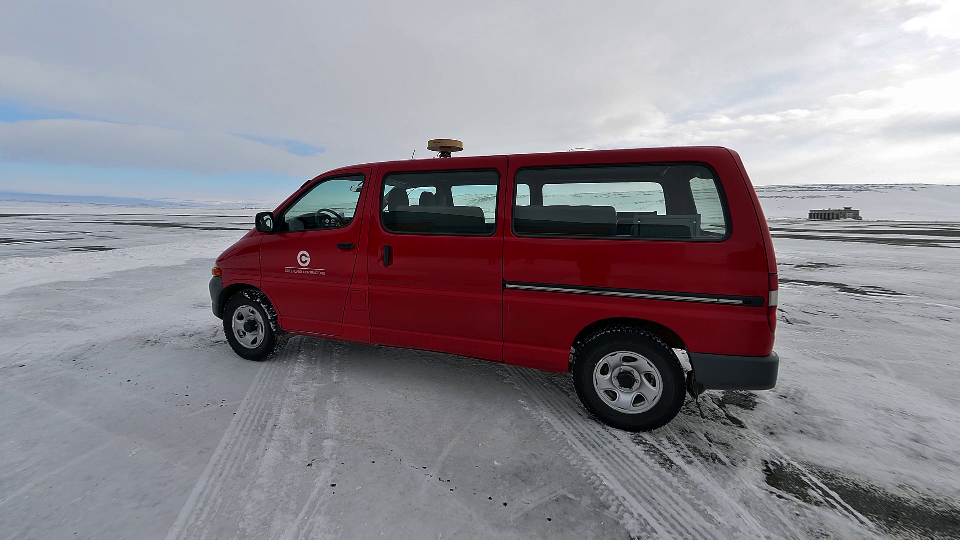
Vehicle equipped with a GPS antenna (on roof) before a ground survey of the ramp at Thule Air Base, Greenland. Credit: NASA / Michael Studinger
Having up-to-date elevation data for the entire ramp is the key to these ramp passes. And although IceBridge is an airborne mission this data is collected on the ground by a GPS antenna-equipped car. By driving this car in a grid pattern over the entire ramp and processing the GPS data in specialized software researchers are able to build an elevation map for the entire ramp. This map gives something researchers can use to check instrument readings, and it also reveals something that many people may not expect.
Airport ramps may appear perfectly level and unchanging, but reality is different. First, the elevation of a ramp varies somewhat from one end to the other. “There is a relief of about 3 or 4 meters across the ramp,” said John Sonntag, ATM senior scientist. This relief gives an added benefit though because the slope gives more data to use for calibration. “If the survey shows a tilt of x degrees and the LiDAR shows a tilt of x plus 1, you know you need to make an adjustment,” Sonntag said.
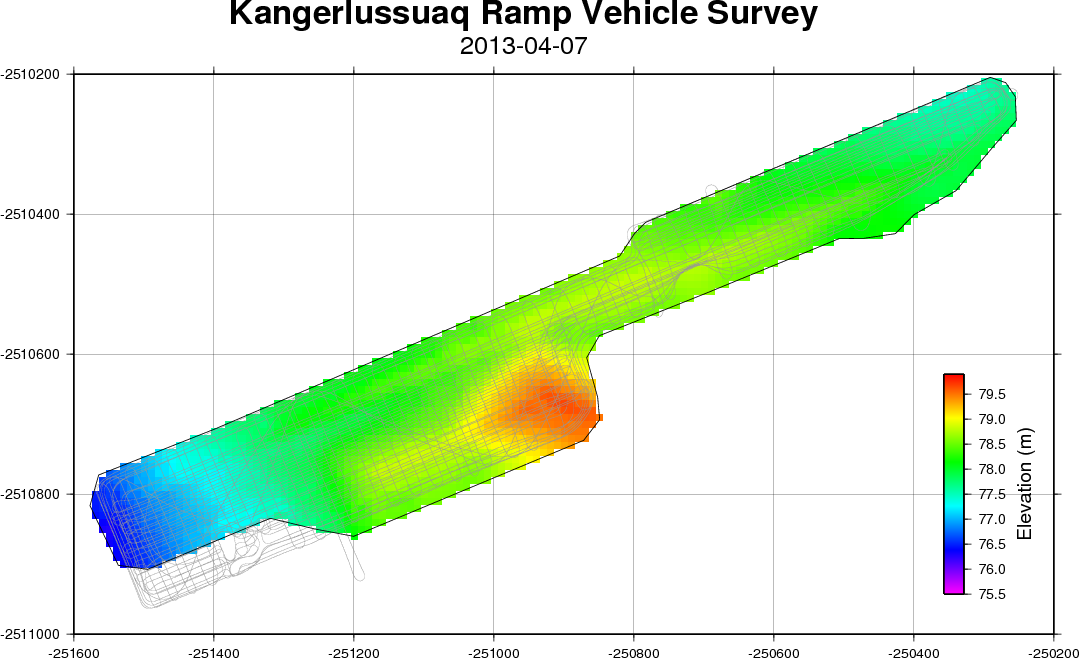
Elevation map from a ground survey of the Kangerlussuaq airport ramp. Credit: NASA / ATM team
In addition to sloping, the ramps in Thule and Kangerlussuaq are changing slightly in elevation over time. Obviously any construction or repaving would change elevation slightly, but even the ground itself is rising. Although solid, Greenland’s bedrock has been pushed down and deformed over the years by the weight of the ice sheet. As Greenland’s ice sheet loses mass this downward force lessens and the bedrock starts rising—a process known as isostatic rebound. “In Thule, we’re seeing a rise of about two centimeters per year,” said Sonntag.
Two centimeters may not seem like much, but even that small of a change could affect instrument accuracy. To avoid this IceBridge does ground surveys of the ramps every year or two. Thanks to these regular surveys and continual checking of instrument calibration IceBridge researchers are able to provide the scientific community with accurate measurements of changing polar ice.
Rock, Ice and Fire: Volcanoes of Greenland's Past
By George Hale, IceBridge Science Outreach Coordinator, NASA Goddard Space Flight Center
During one of IceBridge’s online educational chats we had an interesting question from a fifth grade class in Hanover, N.H. “Are you flying near any volcanoes?” Nearby Iceland is famed for its geothermal activity, with hot springs and geysers, and volcanoes like the one that disrupted European air travel for weeks in 2010 (and caused minor concern for IceBridge mission planners at the same time) by spewing a large cloud of ash into the air.
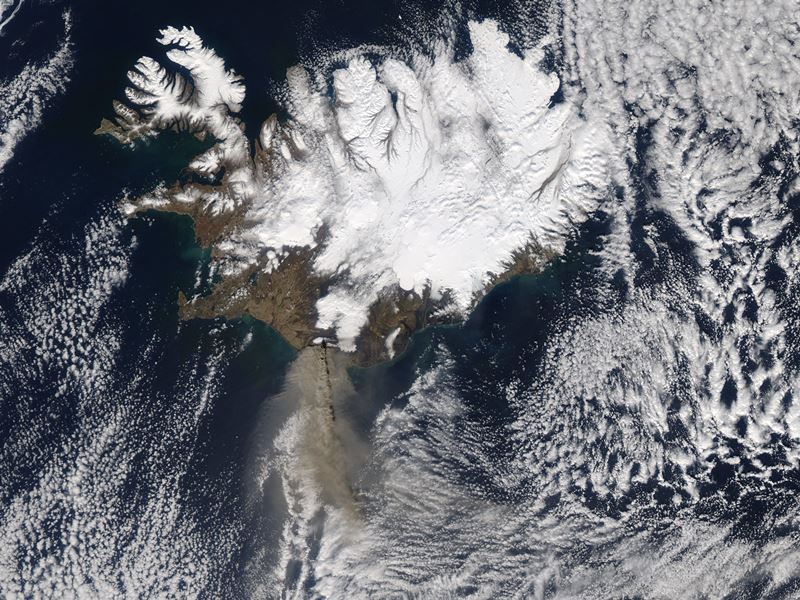
Satellite image of the ash plume from Iceland’s Eyjafjallajökull volcano on Apr. 17, 2010. Credit: NASA / MODIS Rapid Response Team
But unlike Antarctica, which has dozens of active and extinct volcanoes, Greenland is not known for having volcanic activity. Getting a handle on Greenland’s geology is hampered by the fact that the majority of the island is covered with hundreds or thousands of meters of ice. But geologists in the field who have studied the exposed rock along the coasts and on mountains above the ice found evidence of volcanoes in Greenland’s past.
About half of Greenland’s exposed surface is made up of rock ranging between 1.5 billion and just over 3 billion years old, making them some of the oldest on Earth. This rock is part of a large formation that spans from Greenland, through the Canadian Shield down to the Hudson Bay. The majority of Greenland’s bedrock is thought to be made up of this ancient rock, with portions of it bent and folded by motion of Earth’s tectonic plates much like how the Appalachian Mountains in the eastern United States and the Rockies out west were formed.
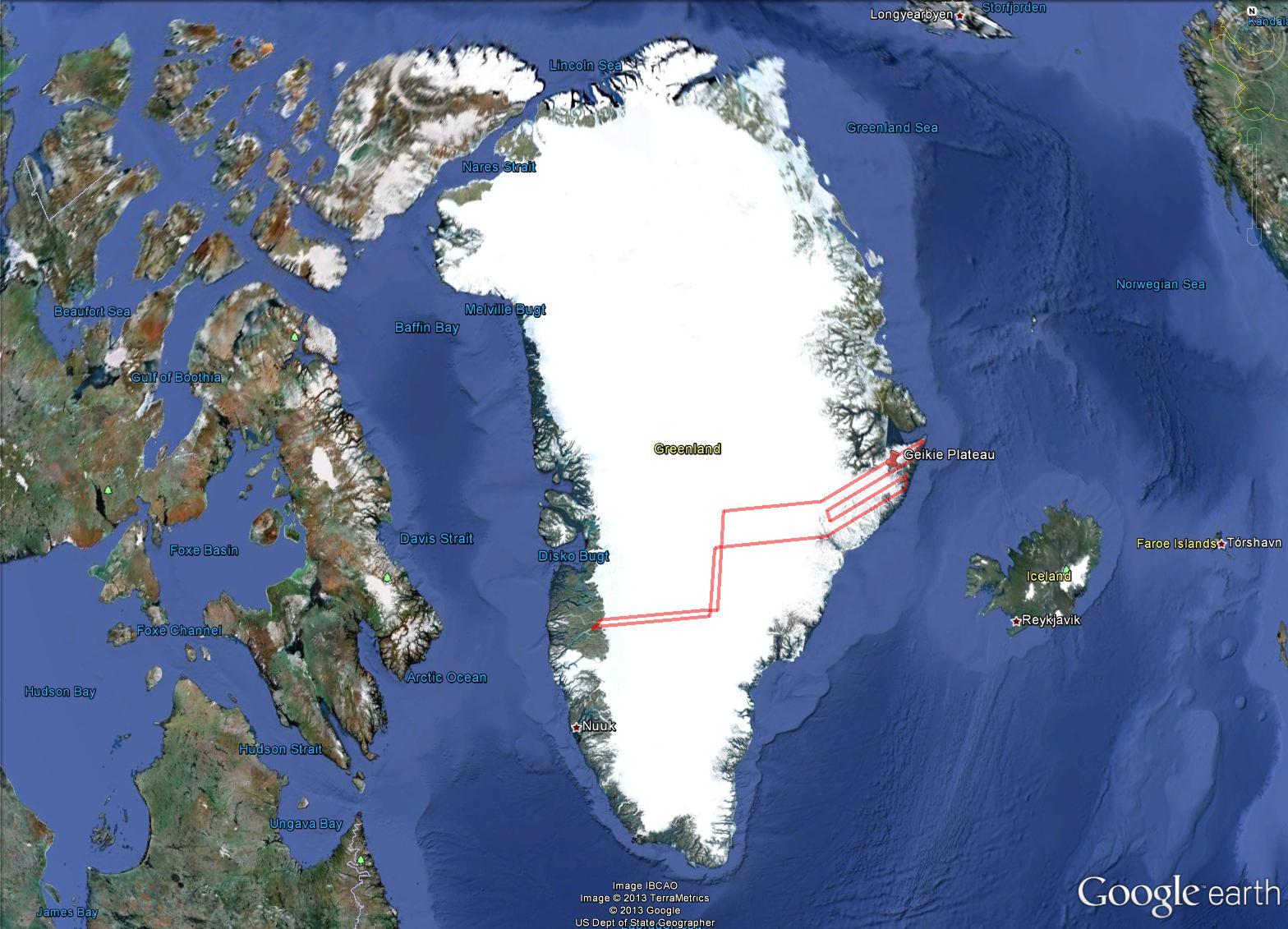
Flight path for Apr. 11 survey of Greenland’s Geikie Peninsula. Credit: NASA
Evidence of past volcanic activity can be seen in sediments carried by Greenland’s glaciers and in one of the most visually striking geologic features in Greenland, the Geikie Peninsula on Greenland’s east coast. And it turns out that this region’s characteristic geology has something in common with present-day volcanic activity in Iceland. Both come from molten rock welling up through a ridge in the middle of the North Atlantic Ocean, a boundary where the North American and Eurasian plates are moving apart.
About 60 million years ago, lava from the mid-ocean ridge flooded out over the landscape, creating a rock formation known as a flood basalt. Repeated floods of lava over the years are what give Geikie’s jagged peaks their distinctive layer cake appearance. Similar geologic structures can be seen in other parts of the world, like the Columbia River Basalt Group in the western United States.
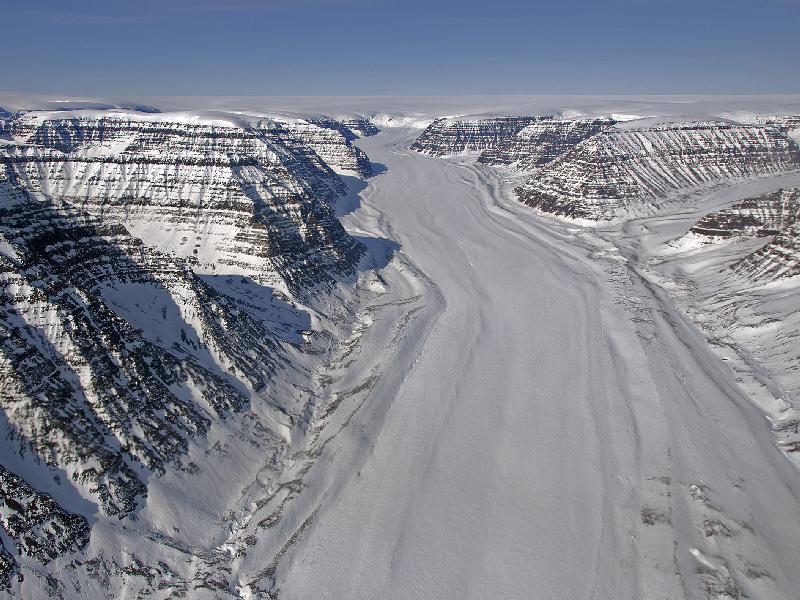
A glacier between mountains on Greenland’s Geikie Peninsula. The mountains on the Geikie Peninsula in Greenland consist mostly of flood basalts formed during the opening of the North Atlantic Ocean millions of years ago. Credit: NASA / Michael Studinger
The answer for those students was no, we weren’t flying near any volcanoes. But we did get to relate our previous experience with the Iceland volcano (and learn that their teacher had a flight delayed because of the same event), and tell them about volcanoes in Greenland’s past.
Live Twitter chat with Operation IceBridge

Have you ever wondered what it’s like to fly over the Arctic while doing scientific research? On April 8, you can follow NASA’s Operation IceBridge and ask questions about how polar researchers work and the science of polar ice as NASA’s P-3B airborne laboratory flies 1500 feet above Greenland’s ice sheet and glaciers.
IceBridge will post live in-flight highlights on Twitter@NASA_ICE from 10 a.m. to 1 p.m. EDT on Monday, April 8 (weather delay date April 9). Follow along during the flight and hear from the scientists,engineers and guest high school science teachers on board. We’ll also be taking your questions. Just use the hashtag #askNASA.

IceBridge Field Work – A Project Manager's Perspective
By Christy Hansen, IceBridge Project Manager, NASA Goddard Space Flight Center
Field work in the Arctic is a unique and challenging experience. It takes an experienced and tough team to complete mission objectives from start to finish despite the biting cold, long days and noisy environment. Early morning temperatures are often in the negative single digits, and the IceBridge team powers through it preparing for flight each day. A typical day’s work can range 12 to 14 hours, a schedule that is repeated daily until the airport is closed or until the flight crew reaches a required hard down day.
My project management perspective allows me to take a step back and appreciate not only the technical expertise of our instrument and flight crew teams, but the masterful choreography that unwinds each day to ensure the P-3B aircraft is prepped and ready, the instruments are powered on and in working condition, and the weather and corresponding science flight plan has been assessed and defined. Being actively involved in all phases of Operation IceBridge makes for a stronger and well-versed leader better able to assist any part of the team at any time. By doing this, I can ensure we are on track to meet our mission and science requirements, assist with troubleshooting in and out of the field, better manage project milestones, and ensure streamlined communication across all IceBridge disciplines with a common goal.
IceBridge project manager Christy Hansen on the stairway to NASA’s P-3B. Credit: NASA / Christy Hansen
But why do we do this? How do we do this?
We do all of this in the name of science, collecting polar geophysical data that will help characterize the health of the Arctic and Antarctic. The in-field data and derived data products IceBridge produces are helping to show annual changes in the ice. These data can be entered into models that can more accurately predict what might happen in the future in terms of ice sheet, glacier, and sea ice dynamics, and ultimately sea level rise; all of which have serious consequences for climate change.
But how do we reach these science goals? The steps and teamwork required are simply astounding. Each part of our team is like a puzzle piece and everyone is needed to complete the puzzle. All teams must clearly know their individual responsibilities, but also be able to work together and mesh where their job ends and another begins.
The choreography starts in the beginning, or planning phase where the science team establishes targets of interest on the ice in accordance with our level 1 science requirements. Then our flight planner designs survey flights, having a unique ability to efficiently mesh the science targets with the range and flight dynamic capabilities of the P-3B aircraft.
Next the aircraft office at NASA’s Wallop’s Flight Facility prepares the P-3B for deployment to some of the harshest environments on Earth and supplies the flight crew that executes the specific flight paths over our required science targets. The instrument teams provide the instrumentation—laser altimeters, radars, cameras and a gravimeter and magnetometer—and expertise in operating equipment and processing data during and after flights. Our logistics team deploys to the field ahead of time, establishing security clearances, local transportation and accommodations, and internet and airport utilities.
Finally, our data center ingests and stores the data that our team collects, ensuring it’s useable and available to the wider community. Our data is not only used by polar scientists and other researchers around the world, it is also used to help satellite missions like the European Space Agency’s CryoSat-2 and NASA’s ICESat-2 calibrate and validate satellite instrumentation.
And finally, a day in the field …
Assuming a standard 8 a.m. local takeoff and eight hour mission duration, we generally have three major groups who follow different schedules pre-flight each morning.
The P-3 maintenance and flight engineer crew typically starts the earliest, heading to the airport about three hours before takeoff. They prep and warm up the plane, conduct some tests and fuel it, all in preparation for the instrument team arrivals and flight operations.
In parallel with aircraft prep, IceBridge’s project scientist, project manager and flight planner team head to the weather office. The team works with local meteorologists, reviewing satellite imagery and weather models to determine the optimal weather patterns that support our flight requirements—clear below 1500 feet, the altitude we typically fly—and final target selection.
In the meantime, the instrument teams arrive at the aircraft to power up and check their systems prior to takeoff. By 7:30 a.m., the aircraft doors close, and we take off by 8. Our eight-hour flights range between flying high and fast, to low and slow over our targets, which include geophysical scans of ice sheets, glaciers, and sea ice.
We typically land around 4 p.m., close out the plane, check data and meet at 5:30 for a science meeting. Many folks continue to work for a few hours afterward, processing data or writing mission reports. All of this is repeated daily, for up to 6 days in a row, which can be exhausting, but in the name of important scientific research, an amazing team, and majestic polar landscapes, I could not imagine anything else.
Crew members working on the P-3B. Credit: NASA / Christy Hansen
Teacher and Science Adviser to Experience IceBridge
By Jette Rygaard Poulsen, Math and Physics Teacher, Hasseris Gymnasium, Aalborg, Denmark

Danish science teacher Jette Rygaard Poulsen
Jette Rygaard Poulsen is the science adviser for the Danish Ministry of Education, and in this role she is participating in developing new subjects for the Danish high schools. One of the latest examples is the combination of physics and geography where a special focus on the Arctic areas could be extremely relevant. Poulsen is working on how Operation IceBridge can contribute. Not only with raw data from measurements, but also with general information on the flying laboratory and the equipment usage. This insight can be coupled directly to the mathematical models the Danish students are already using during their education. Poulsen is also the coordinator of Danish teachers participation in Operation IceBridge.
Apart from her advisory work for the Ministry, Poulsen is also teaching physics and math at the general high school Hasseris Gymnasium in Aalborg, Denmark. Poulsen graduated from Copenhagen University as M.Sc in Meteorology, and has since maintained a special interest in the Arctic climate.
Greenland Teacher to Gain Insight on Arctic Ice
By Mette Noort Hansen, Science Teacher, GU Sisimiut, Sisimiut, Greenland
.jpg)
Sisimiut, Greenland, science teacher Mette Noort Hansen
I teach introductory science, arctic technology, geography and biology to high school students in Sisimiut, Greenland, where I moved to from Denmark in July 2012. I have a M.Sc. in biology and geography and am interested in nature and the environment, both professionally as a teacher and personally in the form of hiking, skiing, botanizing or other activities.
I heard about the possibility of joining the IceBridge mission through a science newsletter for high school teachers in Greenland, and from my colleague Sine, who joined the mission in 2012. I hope that the mission will give me and future students an insight in contemporary research regarding the melting of polar ice, and a better understanding of what the research tells us, compared to what the media tells us.
Following IceBridge I will develop a theme for introductory science, regarding glaciers, the research done in IceBridge, and the definition of science. The product is made available for all science teachers in Greenland in June 2013, as part of a larger web-based teaching-platform for Greenlandic high school teachers.
PolarTREC Teacher's Path to IceBridge
By Mark Buesing, Libertyville High School, Libertyville, Ill.

Libertyville High School physics teacher Mark Buesing
I teach physics and AP physics at Libertyville High School in Libertyville, IL – about 45 miles northwest of Chicago. My undergrad is in electrical engineering from the University of Illinois and I worked for a number of years at Hughes Aircraft in California and Motorola in Illinois. After a short stint as a professional bicycle racer, I found out I was meant to be a high school physics teacher, and earned a graduate degree in secondary education from Roosevelt University. I’ve been teaching now for almost 20 years.
My route to Operation IceBridge was serendipitous. A former student of mine works for the US Antarctic Program, and while in Antarctica, she met a science teacher participating in the PolarTREC program (Teachers and Researchers Exploring and Collaborating). This student sent me an e-mail telling me about the program and encouraged me to apply. That application was selected by Operation IceBridge, which has a very active educational outreach program.
My students asked me what I’ll be doing in Greenland with NASA, and I told them, “You are the next generation of scientists and engineers. Who are the next people NASA will hire to help continue all the research? … You!” So my job is to bring the science Operation IceBridge does back to my class and help motivate students to pursue careers in science and engineering. In the not-too-distant future, if the kids in my class today are working on a project like Operation IceBridge I will have done my job.
From left: Michael Studinger, IceBridge project scientist; Mark Buesing, Libertyville High School physics teacher; and Christy Hansen, IceBridge project manager
Crossing the Basin: IceBridge in Alaska
By George Hale, IceBridge Science Outreach Coordinator, NASA Goddard Space Flight Center
Why does IceBridge fly all the way to Alaska when the rest of the campaign is in Greenland? It’s an understandable question considering how far away these two locations are. But when you consider the economic importance of the regions north of Alaska and how dynamic and varying sea ice in the Arctic is, the picture becomes clearer. Much like last year, the IceBridge team made the 8 hour transit flight from Thule to Fairbanks early in the campaign.

Flight path taken from Thule, Greenland, to Fairbanks, Alaska on Mar. 21, 2013. This route and the more southerly return leg have been flown in every IceBridge Arctic campaign. The flightplan was renamed this year as a tribute to sea ice scientist Seymour Laxon. Credit: NASA
Ice on the Move
At first glance it might be easy to assume that Arctic sea ice is uniform, but the region’s geography, ocean and wind currents and the ever-changing nature of ice itself mean that conditions can vary significantly across the Arctic Basin. “There are lots of different thickness gradients across the basin,” said Jackie Richter-Menge, sea ice scientist with the U.S. Army Corps of Engineers and co-lead of the IceBridge science team.
Ocean currents like the Beaufort Gyre continuously spin in the Arctic Ocean, driving ice cover along the coast of North America toward Greenland where it is compressed into thicker multi-year ice. The presence of multi-year ice is one of the biggest differences between the ice cover off the coast of Greenland and in the region of the Arctic Basin north of Alaska, which is recently dominated by ice that forms in the winter and disappears in the summer.

Digital Mapping System (DMS) image mosaic of ice in the Beaufort Sea. The lighter colored portion at the bottom right is thick sea ice, the darker blue-gray areas are thinner ice and the dark segment in the middle is open water. Credit: NASA / DMS
This seasonal ice cover is becoming more prevalent in areas north of Alaska as the thicker multi-year ice gradually melts. On the Mar. 22 IceBridge flight Richter-Menge saw firsthand how things have changed since she flew over the region earlier in her career in the 1980s. “It was notable how deep we went in the basin without seeing multi-year ice,” Richter-Menge said. IceBridge didn’t see multi-year ice until they were about 1000 kilometers from shore. In the early 1980s it could be found between 150 and 200 kilometers out.
Getting Better Data
These sorts of changes, along with environmental and economic concerns, contributed to the science communities increased desire for data on sea ice this part of the Arctic Basin. IceBridge had conducted transits of the entire basin from Thule to Fairbanks in previous campaigns, but starting in 2012, the mission started doing a temporary deployment in Fairbanks to get more data on areas north of Alaska.
IceBridge’s increased coverage is adding to the body of knowledge on ice in this region adding a new level of detail. “It gives us a more complete view of what’s going on in the basin,” said Richter-Menge. The data collected on these flights give more geographic coverage to IceBridge’s sea ice data products, especially the quick look product that debuted during last year’s Arctic campaign. This dataset came about in response to a need for near real-time sea ice conditions for use in seasonal sea ice forecasts.

Graph of Arctic sea ice volume from the Pan-Arctic Ice Ocean Modeling and Assimilation System (PIOMAS). Credit: Polar Science Center / University of Washington
Along with data on sea ice freeboard, the amount of ice floating above the ocean’s surface, many in the scientific community have taken an interest in IceBridge’s snow depth measurements. Snow depth gives a way to measure changes in precipitation rate and differences in accumulation affect how much snow is available for melt ponds. As conditions warm in the summer, snow melts and accumulates in ponds. These ponds are darker than the surrounding snow, trapping more of the sun’s heat and further accelerating melting.

Jackie Richter-Menge (left) and the IceBridge team before a flight over the Beaufort Sea on Mar. 22, 2013. Credit: NASA / Jim Yungel
Learning and Teaching
As a guest on the flights out of Fairbanks Richter-Menge got a chance to see firsthand how IceBridge collects sea ice data. Being able to witness this complicated and involved process helps give a better-rounded picture of the mission, Richter-Menge said. In addition to the data-collection that takes up each flight, Richter-Menge got to see the work it takes to choose which mission to fly each morning. “It was impressive to watch the whole decision-making process for choosing flight lines,” said Richter-Menge.
And as is often the case, the flow of information goes both ways. Richter-Menge and fellow sea ice scientist Sinead Farrell spent plenty of time on their flights sitting at a window aboard the P-3 and explaining what everyone was seeing. “We are learning a lot about sea ice with them here,” said Christy Hansen, IceBridge’s project manager.
NASA Operation IceBridge: Notes from the Field (Arctic 2013)
By Sinead Farrell, Sea Ice Scientist, NASA Goddard Space Flight Center / University of Maryland
Editor’s note: This entry was originally posted on the Scientist’s Soapbox, a blog published by the Earth Science System Interdisciplinary Center at the University of Maryland in College Park, Md.
Introduction:
The NASA Operation IceBridge mission began the Arctic 2013 research campaign on Monday 20th March. The mission will survey the Greenland Ice Sheet and sea ice pack of the Arctic Ocean. The NASA IceBridge mission is now in its fifth year and continues to measure Arctic sea ice thickness and snow depth. These data continue the time series of ice thickness measurements begun with NASA’s ICESat in 2003, and will provide a link to the NASA ICESat-2 mission, due for launch in mid-2016.
Surveys are conducted using a specially-equipped P-3B research aircraft (see photo below) that flies above the ice carrying a number of science instruments including radar and laser altimeters, and high-resolution cameras. This year the first flight took place from Thule, Greenland over Arctic sea ice north of the Lincoln Sea, on Wednesday 20th March. IceBridge flew beneath the European Space Agency’s CryoSat-2 satellite, that carries a special radar altimeter known as SIRAL. The mission was designed to fly a gridded-survey beneath the satellite to help validate CryoSat’s measurements over sea ice. The aircraft then transited from Thule across the Arctic Ocean to Alaska on Thursday 21st March. Over the coming days IceBridge will attempt a number of sea ice flights over the Beaufort and Chukchi Seas from a base at Fairbanks International Airport, Alaska. ESSIC’s Sinead Farrell hopes to participate in the first Alaska mission on Friday 22nd March, pending good weather. Dr. Farrell is a sea ice scientist and member of the NASA IceBridge science team.
View of a sea ice lead from the NASA P-3B. Credit: NASA / Christy Hansen
Daily Blog Posts:
Tuesday 19th March: Arrived in Fairbanks, Alaska on Tuesday to slightly warmer spring temperatures than I had expected. After organizing a rental car, figuring out how to use the engine heating block and the all-wheel drive, I headed for the hotel to unpack and (re)familiarize myself with the locale. The last time I enjoyed an extended visit to Fairbanks was exactly ten years ago, while I was conducting my graduate studies at University College London. Back then I also participated in a NASA airborne campaign over the Chukchi, Beaufort and Bering Seas aimed at validating the NASA AMSR-E radiometer. Things have not changed much in Fairbanks over the years!
Wednesday 20th March: The first in a series of IceBridge science flights was successfully completed on Wednesday. Although the mission was conducted far away over Arctic sea ice northwest of Greenland it was nonetheless a very exciting mission to follow. I was involved in designing a set of gridded flight-lines over the ice such that our airborne survey would provide temporally and spatially coincident measurements with CryoSat-2, while it passed high over-head. This is a technically challenging flight to conduct but things worked out well. The sea ice appeared more dynamic than we had expected, but the number of cracks in the ice, known as “leads”, will actually help in the data analysis aimed at inferring sea ice thickness. While waiting for the IceBridge mission to transit from Greenland to Alaska, I will spend time visiting the International Arctic Research Center (IARC), at the University of Alaska – Fairbanks (UAF). On Wednesday I had the opportunity to meet with some of my colleagues at IARC to discuss on-going and future projects to better understand the diminishing Arctic sea ice pack. I was also able to attend a lecture by Dr. Ron Kwok of NASA’s Jet Propulsion Laboratory on the topic of “Recent Changes in the Arctic Sea Ice Cover: A remote sensing perspective”. Fortuitously there are many national and international sea ice scientists visiting UAF right now to participate in meetings and workshops. Some are even en route to conduct field-work on the sea ice near Barrow, Alaska. Although it’s very cold (-19 degrees Celsius this morning!) and snowing, this is a great time of the year to be in Fairbanks!
Thursday 21st March: Thursday began with the exciting news that the NASA P-3 was en route to Fairbanks. Today’s mission from Greenland to Alaska was flown along what is called the “Laxon Line”. The flight is named in honor of University College London Professor Seymour Laxon. Seymour, my graduate advisor, died tragically 3 months ago. Seymour was a pioneer in the use of satellite altimeters to study sea ice and was the lead sea ice scientist on the CryoSat-2 mission. Today we measured ice thickness and snow depth along a flight line that crosses most of the Arctic Ocean. Thanks to a good tail-wind the P-3 landed one hour early in Fairbanks, right around lunch time. I was really lucky to watch the plane land with my colleagues Jackie Richter-Menge from the Cold Regions Research and Engineering Laboratory (CRREL) and Pam Posey from the Naval Research Laboratory (NRL). Once through customs we met our colleagues off the plane and welcomed them to snowy Alaska!
Friday 22nd March: On Friday we hope to conduct a third sea ice mission over the Arctic, weather permitting. We always need good weather to fly our surveys since clouds can potentially interrupt the measurements we make from the aircraft. We’re particularly interested to see what is happening to the sea ice in the Southern Beaufort Sea this year after the ice pack suffered a wide-spread “break out” event in mid-February. This event caused the ice pack to fragment into smaller floes and become more dynamic. Although these break-out events are not unusual in this region, they do not normally happen in February, the dead of winter. We will provide more updates as the day progresses.
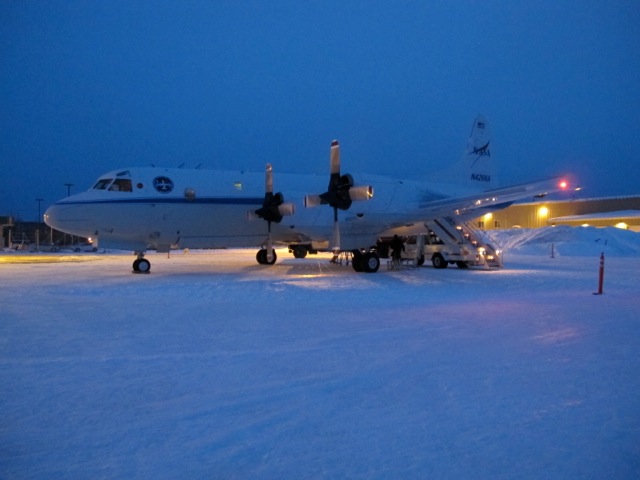
The NASA P-3B on the ramp at Fairbanks, Alaska. Credit: NASA / Jim Yungel



